国际经济学1-2
- 格式:doc
- 大小:382.50 KB
- 文档页数:9



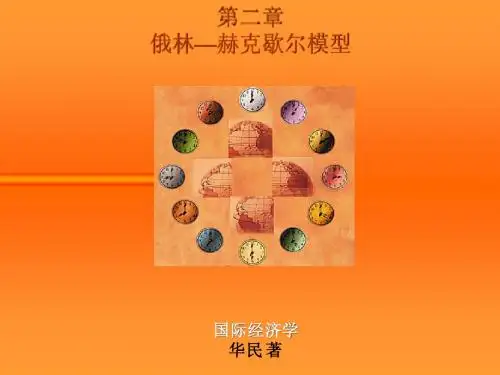
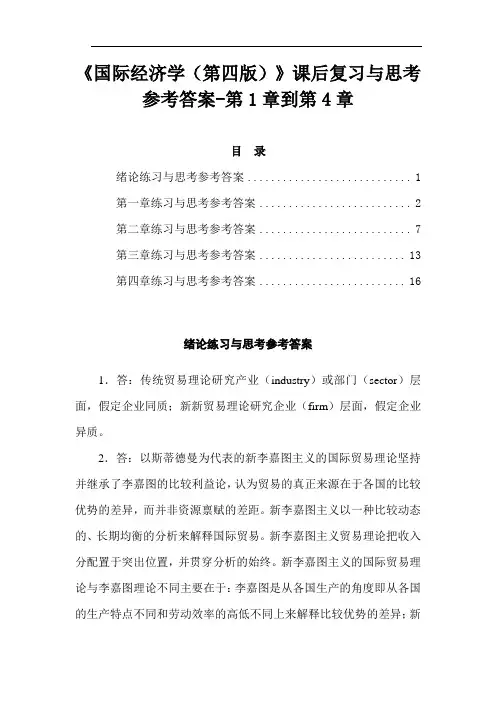
《国际经济学(第四版)》课后复习与思考参考答案-第1章到第4章目录绪论练习与思考参考答案 (1)第一章练习与思考参考答案 (2)第二章练习与思考参考答案 (7)第三章练习与思考参考答案 (13)第四章练习与思考参考答案 (16)绪论练习与思考参考答案1.答:传统贸易理论研究产业(industry)或部门(sector)层面,假定企业同质;新新贸易理论研究企业(firm)层面,假定企业异质。
2.答:以斯蒂德曼为代表的新李嘉图主义的国际贸易理论坚持并继承了李嘉图的比较利益论,认为贸易的真正来源在于各国的比较优势的差异,而并非资源禀赋的差距。
新李嘉图主义以一种比较动态的、长期均衡的分析来解释国际贸易。
新李嘉图主义贸易理论把收入分配置于突出位置,并贯穿分析的始终。
新李嘉图主义的国际贸易理论与李嘉图理论不同主要在于:李嘉图是从各国生产的角度即从各国的生产特点不同和劳动效率的高低不同上来解释比较优势的差异;新李嘉图主义不仅从各国生产的角度来分析和比较各国的比较优势的差异,而且强调要从各国分配领域,从经济增长、经济发展的动态角度来分析和比较各国比较优势的不同。
3.答:北京师范大学李翀教授认为,马克思曾经有一个六册著作的写作计划,准备研究国内和国际经济问题,建立一个完整的经济理论体系。
然而遗憾的是,马克思没有能够完成他的研究工作。
将马克思经济学的基本理论和基本方法应用于国际经济问题的研究,构建马克思主义国际经济学理论体系,是一个很有意义的研究领城。
随着经济的全球化,国际经济体系已经成熟,建立马克思主义国际经济学的条件已经具备。
国际经济的本质是资本的跨国流动,因此,应该从商品资本、生产资本、货币资本的跨国流动三个方面来构建马克思主义国际经济学。
在商品资本的跨国流动方面,需要从国际价值、生产价格和垄断价格等基本范畴出发,来分析国际贸易的原因、流向和利益分配。
在生产资本的跨国流动方面,需要从生产资本本质的角度重新构建直接投资的原因、流向和利益分配。
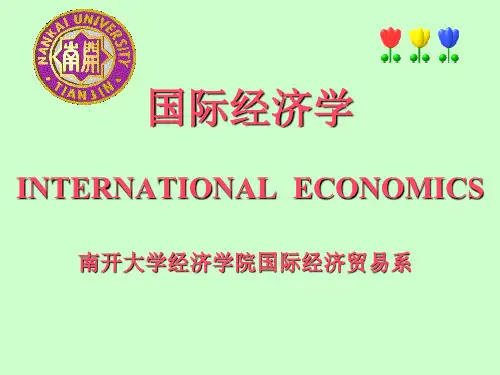
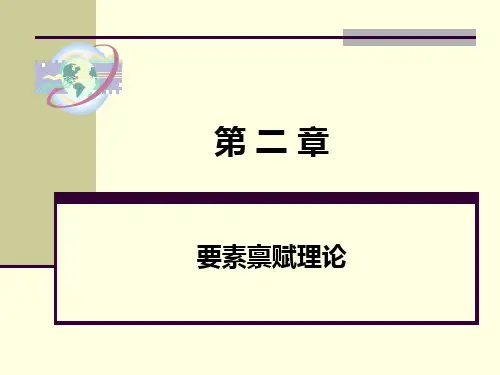

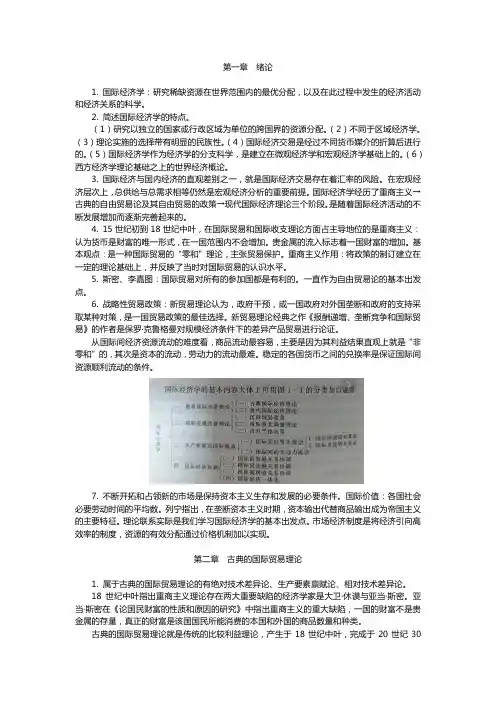
第一章绪论1. 国际经济学:研究稀缺资源在世界范围内的最优分配,以及在此过程中发生的经济活动和经济关系的科学。
2. 简述国际经济学的特点。
(1)研究以独立的国家或行政区域为单位的跨国界的资源分配。
(2)不同于区域经济学。
(3)理论实施的选择带有明显的民族性。
(4)国际经济交易是经过不同货币媒介的折算后进行的。
(5)国际经济学作为经济学的分支科学,是建立在微观经济学和宏观经济学基础上的。
(6)西方经济学理论基础之上的世界经济概论。
3. 国际经济与国内经济的直观差别之一,就是国际经济交易存在着汇率的风险。
在宏观经济层次上,总供给与总需求相等仍然是宏观经济分析的重要前提。
国际经济学经历了重商主义→古典的自由贸易论及其自由贸易的政策→现代国际经济理论三个阶段。
是随着国际经济活动的不断发展增加而逐渐完善起来的。
4. 15世纪初到18世纪中叶,在国际贸易和国际收支理论方面占主导地位的是重商主义:认为货币是财富的唯一形式,在一国范围内不会增加。
贵金属的流入标志着一国财富的增加。
基本观点:是一种国际贸易的“零和”理论,主张贸易保护。
重商主义作用:将政策的制订建立在一定的理论基础上,并反映了当时对国际贸易的认识水平。
5. 斯密、李嘉图:国际贸易对所有的参加国都是有利的。
一直作为自由贸易论的基本出发点。
6. 战略性贸易政策:新贸易理论认为,政府干预,或一国政府对外国垄断和政府的支持采取某种对策,是一国贸易政策的最佳选择。
新贸易理论经典之作《报酬递增、垄断竞争和国际贸易》的作者是保罗·克鲁格曼对规模经济条件下的差异产品贸易进行论证。
从国际间经济资源流动的难度看,商品流动最容易,主要是因为其利益结果直观上就是“非零和”的,其次是资本的流动,劳动力的流动最难。
稳定的各国货币之间的兑换率是保证国际间资源顺利流动的条件。
7. 不断开拓和占领新的市场是保持资本主义生存和发展的必要条件。
国际价值:各国社会必要劳动时间的平均数。
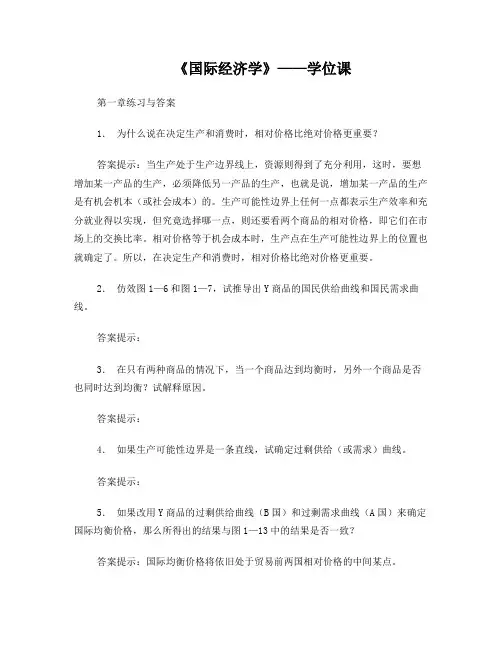
《国际经济学》——学位课第一章练习与答案1.为什么说在决定生产和消费时,相对价格比绝对价格更重要?答案提示:当生产处于生产边界线上,资源则得到了充分利用,这时,要想增加某一产品的生产,必须降低另一产品的生产,也就是说,增加某一产品的生产是有机会机本(或社会成本)的。
生产可能性边界上任何一点都表示生产效率和充分就业得以实现,但究竟选择哪一点,则还要看两个商品的相对价格,即它们在市场上的交换比率。
相对价格等于机会成本时,生产点在生产可能性边界上的位置也就确定了。
所以,在决定生产和消费时,相对价格比绝对价格更重要。
2.仿效图1—6和图1—7,试推导出Y商品的国民供给曲线和国民需求曲线。
答案提示:3.在只有两种商品的情况下,当一个商品达到均衡时,另外一个商品是否也同时达到均衡?试解释原因。
答案提示:4.如果生产可能性边界是一条直线,试确定过剩供给(或需求)曲线。
答案提示:5.如果改用Y商品的过剩供给曲线(B国)和过剩需求曲线(A国)来确定国际均衡价格,那么所得出的结果与图1—13中的结果是否一致?答案提示:国际均衡价格将依旧处于贸易前两国相对价格的中间某点。
6.说明贸易条件变化如何影响国际贸易利益在两国间的分配。
答案提示:一国出口产品价格的相对上升意味着此国可以用较少的出口换得较多的进口产品,有利于此国贸易利益的获得,不过,出口价格上升将不利于出口数量的增加,有损于出口国的贸易利益;与此类似,出口商品价格的下降有利于出口商品数量的增加,但是这意味着此国用较多的出口换得较少的进口产品。
对于进口国来讲,贸易条件变化对国际贸易利益的影响是相反的。
7.如果国际贸易发生在一个大国和一个小国之间,那么贸易后,国际相对价格更接近于哪一个国家在封闭下的相对价格水平?答案提示:贸易后,国际相对价格将更接近于大国在封闭下的相对价格水平。
8.根据上一题的答案,你认为哪个国家在国际贸易中福利改善程度更为明显些?答案提示:小国。
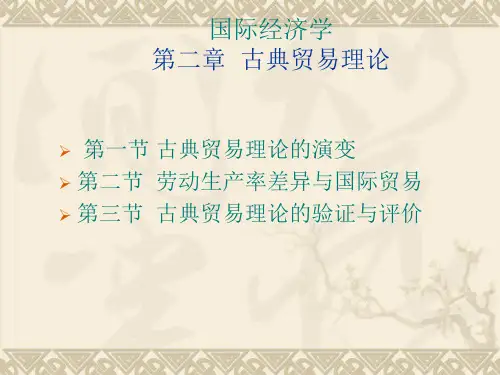
国际经济学(一)提取自陈爱贞老师的课件BY Clark绪论•主要参考文献:萨尔瓦多:《国际经济学》(第9版),清华大学出版社2008年.凯伯:《国际经济学》(第8版),机械工业出版社2002年.海闻等:《国际贸易》,格致出版社2003年。
•主要相关杂志:《经济研究》、《管理世界》、《世界经济》、《中国工业经济》、《国际贸易问题》、《American Economic Review》、《Journal of International Economics》、《International Economic Review》、《Journal of International Management》。
•主要统计年鉴:《中华人民共和国海关统计年鉴》、《中国统计年鉴》、《世界统计年鉴》、《国际统计年鉴》《中国对外经济统计年鉴》(2006年起改为《中国贸易外经统计年鉴》)、《中国对外经济贸易年鉴》。
•获取相关资料的网站: 厦门大学图书馆中文和外文资料库、人大经济论坛、中华人民共和国商务部、中国经济学教育科研网。
•国际贸易分类标准(SITC)与国内使用的进出口商品分类标准(HS)不同,使用时需要统一口径。
•授课内容安排•第1章序言•第2章•第3章•第4章•第5章•第6章•第8章•第9章•第10章•第11章第1章序言•本章结构•开放条件下国际经济学的重要性•国际经济学是关于什么的学科•当前国际经济学的主要内容•当前国际经济面临的问题•当前中国对外贸易的主要问题开放条件下国际经济学的重要性•全球出口总额占全球GDP的比重从1993年的19%上升到2005年的28.8%。
•据海关统计,自2002年中国正式加入WTO以来,中国对外贸易增长速度连续六年保持在20%以上,进出口规模翻了两番。
•中国海关总署发布的统计数据表明,2007年,中国外贸进出口总额达2.1738万亿美元(2007年中国GDP为2.466万亿美元);2008年,中国外贸进出口总额为2.5616万亿美元;2009年,2.2073万亿美元(2009年中国GDP为4.9093亿美元).•联合国贸发会议2008年公布的《世界投资报告》表明,2007年,国际直接投资流量1.83万亿美元。
国际经济学Chapter 1 PrefaceThe Importance of International EconomicsThe Subject Matter of International EconomicsPurpose of International Economic TheoriesStructure & Reference BooksThe subject matter of international economics:International economics deals with economic interactions that occur between independent nations. It analyzes the flow of goods, services, payments, and money between a nation and the rest of the world, the policies directed at regulating these flows, and their effect on the nation’s welfare.P1-2The subject matter of international economics:(1) International trade theory(2) International trade policy(3) Foreign exchange markets(4) Balance of payments(5) Open economy macroeconomicsQ: What are they about?Key ConceptsInternational trade theory analyzes the basis and the gains from trade.International trade policy examines the reasons for and the effects of trade restrictions and new protectionism. Foreign exchange markets are the framework for the exchange of one national currency for another.Balance of payments measures a nation`s total receipts from and the total payments to the rest of the world. Open economy macroeconomics deals with the mechanisms for adjustment in balance of payments disequilibria (deficits and surplus) as well as the the effects of the macroeconomics interdependence among nations under different international monetary systems , and their effect on a nation`s welfare.⏹The Gains from TradeMany people are skeptical about importing goods that a country could produce for itself.When countries sell goods and services to one another, all countries benefit.Trade and income distributionInternational trade might hurt some groups within nations.Trade, technology, and wages of high and low-skilled workers.⏹The Pattern of Trade (who sells what to whom?)Climate and resources determine the trade pattern of several goods.In manufacturing and services the pattern of trade is more subtle.- International difference in labor productivity.- The relative supplies of national resources such as capital, labor, and land on one side and the relative use of these factors in the production of different goods on the other.- A substantial random component.国际贸易理论的发展重商主义托马斯·曼17世纪绝对优势理论亚当-斯密18世纪比较优势理论大卫-李嘉图19世纪要素禀赋理论赫克歇尔-俄林20世纪初新古典贸易理论里昂惕夫、林德、波斯纳、维农20世纪初-20世纪70年代国际贸易理论的发展新贸易理论克鲁格曼20世纪70年代-今[1.产业内贸易的迅速发展格鲁贝尔、劳埃德2.产业组织理论的发展迪克希特、斯蒂格利茨]垄断竞争理论克鲁格曼、埃塞尔20世纪80年代⏹Protectionism?Many governments are trying to shield certain industries from international competition.This has created the debate dealing with the costs and benefits of protection relative to free trade.Advanced countries’ policies engage in industrial targeting.Developing count ries’ policies promote industrialization.⏹Exchange Rate DeterminationThe role of changing (floating)exchange rates is at the center of international economics.⏹The Balance of PaymentsSome countries run large trade surpluses.For example, in 1998 both China and South Korea ran trade surpluses of about $40 billion each.Is it good to run a trade surplus and bad to run a trade deficit?⏹International Policy CoordinationA fundamental problem in international economics is how to produce an acceptable degree of harmonyamong the international trade and monetary policies of different countries without a world government that tells countries what to do.⏹The International Capital MarketThere are risks associated with international capital markets:Currency Value FluctuationNational default国际金融理论的发展价格铸币流动机制大卫-休谟16世纪金本位制纳克斯第一次世界大战前金块本位制、金汇兑本位制——两次世界大战之间布雷顿森林体系凯恩斯第二次世界大战后-20世纪70年代最佳货币区理论罗伯特-蒙代尔20世纪60年代-今国际金融理论的发展浮动货币体系托宾、弗里德曼20世纪80年代-今[1.国际收支的货币分析法;[2.资产组合理论模型;[3.长期国际收支分析。
理性预期学派和跨时选择理论布兰查德20世纪80年代Purpose of international economic theories and policiesThe purpose of economic theory in general is to predict and explain.Learning Structure-1Learning Structure-2Reference Books多米尼克·萨尔瓦多.《国际经济学》(第9版).清华大学出版社。
保罗·克努格曼.《国际经济学(理论与政策)》(第6版).中国人民大学出版社。
罗伯特.J.凯伯.《国际经济学》(原书第8版).机械工业出版社。
Chapter 2 The Law of Comparative AdvantageQuestions we seek to answer in this chapter:(1) What is the basis for trade and what are the gains from trade?(2) What is the pattern of trade?Assumptions in international trade theory(1)two-nation, two-commodity world;(2)no trade restrictions to begin with;(3)perfect mobility of factors within the nations but no international mobility;(4)perfect competition in all commodity and factor markets;(5)no transportation costs.2.1 The Mercantilists’ Views on TradeA nation should export more than import to be rich and powerful, so the government have to do all in its power to stimulate the nation’s exports and discourage and restrict imports (especially the import of luxury consumption goods).托马斯·曼:《贸易带给英格兰的财富》2.2 Trade Based on Absolute AdvantageAbsolute advantageWhen one nation is more efficient than another in the production of one commodity but is less efficient than the other nation in producing a second commodity, then both nations can gain by each specializing in the production of the commodity of its absolute advantage and exchanging part of its output with the other nation for the commodity of its absolute disadvantage.The Law of Absolute advantage所有国家都可以通过自由贸易获利,倡导自由放任(laissez-faire,即政府尽可能少的干涉经济活动)。